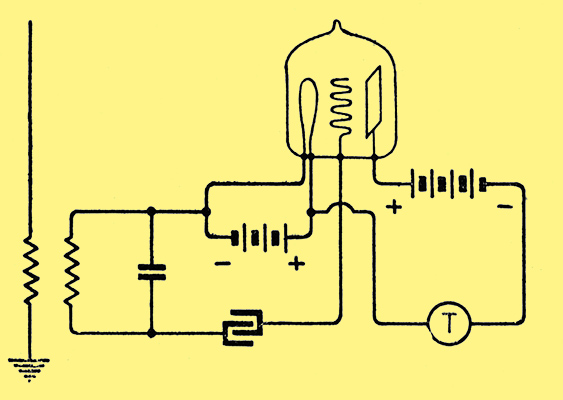|

This diagram from de Forests 1907 patent specification might, except for the absence of a grid leak, be dated 1943.
It was in January, 1907, that Lee de Forest filed the patent on the insertion of the grid in the valve.
Dr de Forest, America's 'Father of Radio', addressing the US National Association of Broadcasters, in a letter in a Chicago newspaper, asks, 'What have you gentlemen done with my child? He was conceived as a potent instrumentality for culture, fine music, the uplifting of America's mass intelligence. You have debased this child . . . you have made him a laughing stock of intelligence'.
In a special de Forest anniversary number of our New York contemporary, Radio Craft, the inventor, now 73 years old, contributes an article on 'How the audion was invented'.Describing the building of the first valve containing a platinum plate and carbon filament he writes: 'The plate was connected to the positive side of the dry battery; the negative terminal to the filament. In series was a telephone receiver. This device was not the Fleming valve. It has always been quite impossible for me to understand the confused idea, in the minds of some otherwise keen thinkers, that the audion differed from the Fleming valve merely by the insertion of a third electrode. Without the use of the B-battery the valve would be nothing but a rectifier with one too many electrodes. The employment of the local battery in the plate circuit is just as necessary an element to the success of the device as the grid'.
Writing on 'Early Radio Inventions' in our sister journal, Wireless Engineer (November, 1943), Professor G W O Howe, said of de Forest's insertion of the grid in the valve, 'This will surely rank for all time as one of the greatest inventions of radio telegraphy'.
10F9 | Pentode RF amplifier primarily designed to work in the IF stage of a receiver: working mutual conductance, 2.4 mA/V. Similar to the VP133, but is designed to work with the same operating potentials on input grid and screen grid as the 10C1. This enables the number of resistors and capacitors in the receiver to be reduced. |
|
In recognition of the 40th anniversary of his invention, de Forest was awarded the Edison Medal by the American IEE.
|